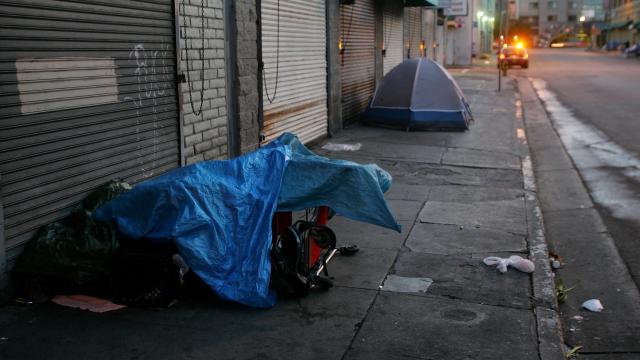A disease infamous for sickening soldiers during World War I is popping up again among one of the most vulnerable populations: people struggling with homelessness. In a new case report out this week, doctors detail how a 48-year-old man in Manitoba, Canada developed a life-threatening heart infection from a bacterial disease known as trench fever. Similar cases have been reported elsewhere in the area, as well as in the U.S. recently.
Trench fever, spread by body lice, is caused by the bacteria Bartonella quintana. Its namesake fever is very distinctive, since it often reappears for five days at a time. Other acute symptoms include rashes, headache, and leg and shin pain.
The disease was first discovered in soldiers during World War I, likely infecting over a million people between 1915 and 1918. This spread was aided by terrible living conditions in the trenches, where nearly all soldiers carried body lice and were forced into cramped quarters. Effective antibiotics were still a decade away from being a reality. Later research has suggested that these bacteria have been infecting humans for at least 400 years.
[referenced id=”1514481″ url=”https://gizmodo.com.au/2020/09/a-climate-anomaly-worsened-world-war-i-and-the-1918-flu-pandemic-new-research-suggests/” thumb=”https://gizmodo.com.au/wp-content/uploads/2020/09/26/fze2lcrejnfseranqwsn-300×168.png” title=”A ‘Climate Anomaly’ Worsened World War I and the 1918 Flu Pandemic, New Research Suggests” excerpt=”A once-in-a-century “climate anomaly” exacerbated the awful conditions along the Western Front in Europe during the First World War, according to new research. This unusual weather may have also amplified — and possibly even initiated — the catastrophic 1918-19 flu pandemic, exposing an underappreciated threat posed by climate change.”]
Though trench fever is rarely fatal by itself, it often sickened soldiers so severely that they became unable to fight for months, and it left some with crippling disabilities. If left untreated, it can also cause endocarditis, or a life-threatening inflammation of the heart’s inner lining. Thankfully, it’s now treatable by antibiotics, and the wide use of louse-killing pesticides limited its impact during World War II (the lice connection was confirmed just as World War I came to an end in 1918).
Since the 1990s, however, doctors have been reporting sporadic outbreaks of B. quintana in the homeless population, with some calling for the disease to be rechristened as urban trench fever. This new paper, published Monday in the Canadian Medical Association Journal, is one such report.
According to the paper, a 48-year-old man with a history of homelessness visited an emergency room in Manitoba with symptoms of chest pain and shortness of breath. During the 18 months leading up to the visit, he had sought care for repeated bouts of chest pain as well as body lice infestation. He had housing at the time but had been living in a shelter recently.
Ten hours into his ER visit, the man’s breathing deteriorated and he became dangerously oxygen deprived, necessitating a ventilator and admission to the intensive care unit. Imaging later revealed that two of his heart valves were so severely damaged that they needed to be replaced. Before he was given antibiotics as a precaution, initial tests failed to find any infectious cause of his symptoms. That’s because, unlike many bacteria, Bartonella germs survive by living inside our cells, which makes it harder to detect an infection. Once the doctors performed specialised tests, they discovered the presence of B. quintana in his blood.
Two weeks after his valve replacement surgery, and while continuing antibiotic therapy, the man was discharged from the hospital. Three months later, a followup visit showed that he was still doing well, the doctors wrote.
It’s likely that trench fever is making many people struggling with homelessness sicker than we know. Though the authors could only find four other documented cases of trench fever in Canada prior to their report, they subsequently found three other cases over a six-month period, all of whom had visited the same homeless shelter in Winnipeg recently. Unfortunately, two of these other cases developed lingering neurological complications, including paralysis and aphasia (the loss of language skills), while the third case recovered but needed a heart valve replacement.
This May, doctors in California also reported a local case of a 48-old-year man experiencing homelessness who likely developed trench fever-related endocarditis in 2019. Unfortunately, soon after a valve replacement surgery, the man went into shock and died two days later of cardiac arrest. His initial infection, only confirmed post-mortem, may have been contracted through exposure to his pet cats, the authors speculated, since they can also carry Bartonella bacteria (another well-known disease caused by these bacteria is called “cat scratch fever.”)
These cases are all the more tragic because trench fever is entirely preventable through delousing and treatable with antibiotics long before it gets to the point where it becomes life-threatening. These outbreaks, perhaps more than anything, highlight the lack of resources that many experiencing homelessness continue to face day in and day out.
The authors recommend that people living with homelessness should have more access to treatments for body lice as well as better shelter conditions, if not stable housing altogether. Doctors should also more readily test for trench fever when they see sick patients who have a history of body lice and more research should be done to confirm how often trench fever is happening among those experiencing homelessness as well.
